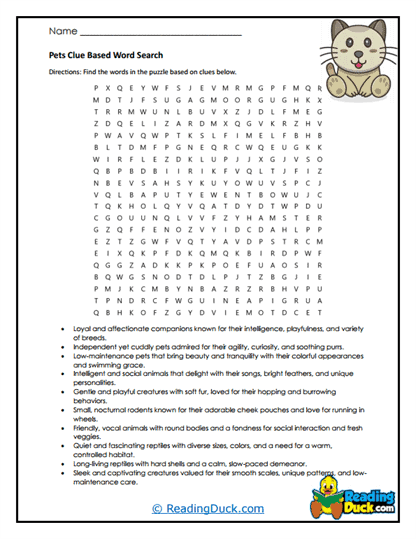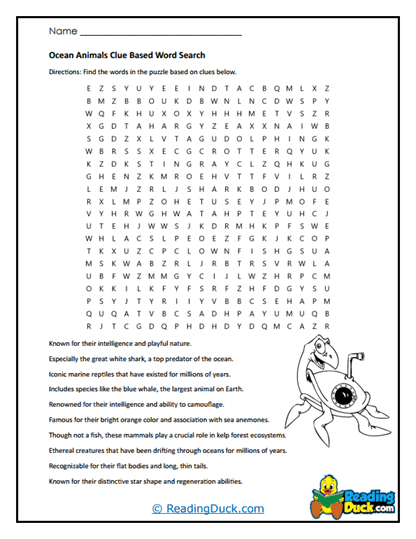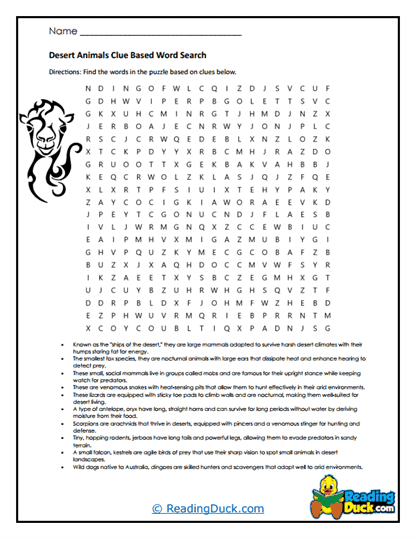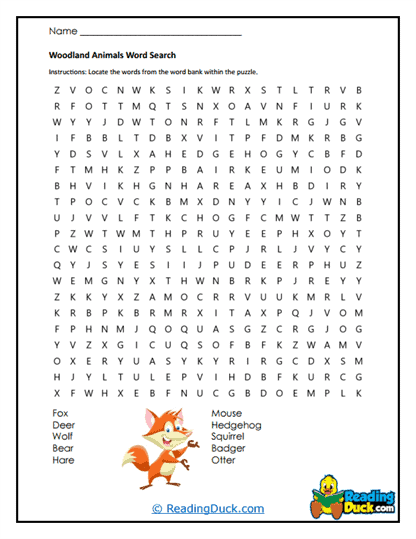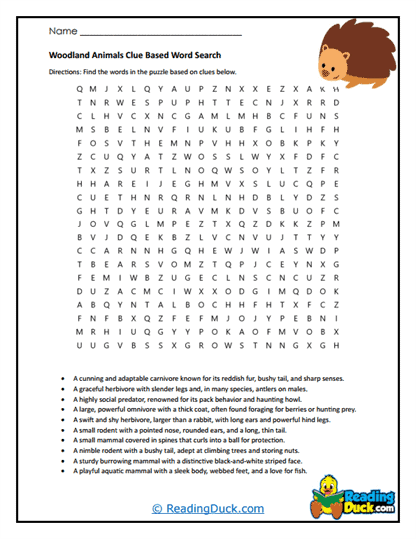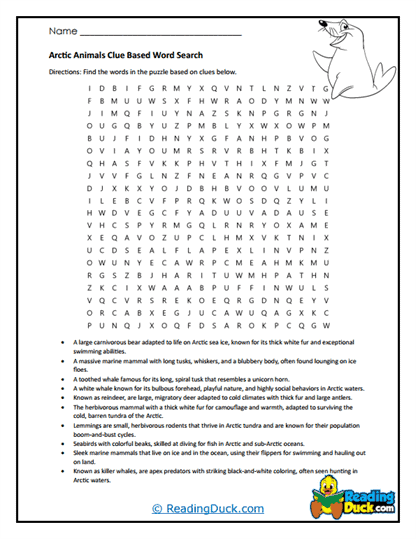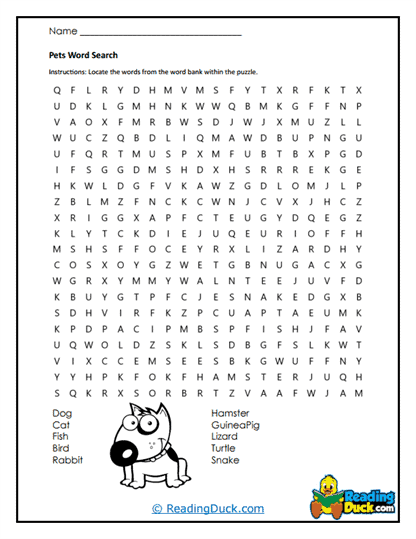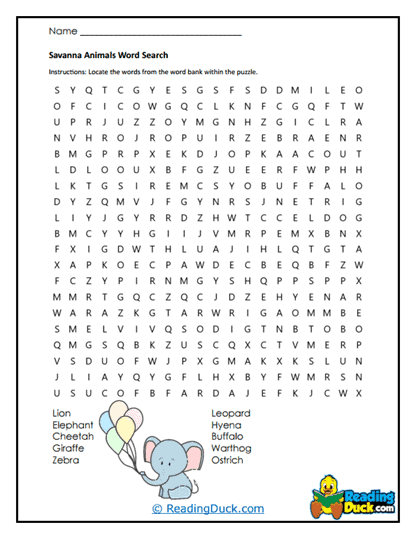Animal Word Searches Worksheets
About Our Animal Word Searches
At their core, these worksheets consist of a grid filled with letters where specific animal-related words are hidden horizontally, vertically, diagonally, or even backward. The challenge for students is to locate and circle these words, usually guided by a list of the terms they need to find.
While the format may seem simple, the benefits of engaging with animal word searches extend far beyond just word recognition. These worksheets offer a multidimensional approach to learning, addressing different aspects of language arts such as vocabulary building, spelling, reading fluency, comprehension, and cognitive skills. Below is an explanation of what these worksheets are, how they work, and the ways they can enhance a student's language arts abilities.
The words included in these worksheets are based on themes, such as "forest animals," "ocean creatures," "endangered species," or "animals that start with a specific letter." The thematic focus enhances students' ability to categorize and contextualize information.
Worksheets are tailored to match the learner's age or skill level. Simpler grids with fewer words are suitable for young learners, while more complex grids with challenging vocabulary cater to older students.
Types of Animal Word Searches
Animal word searches in this collection provide an exciting, thematic approach to language learning while introducing students to diverse ecosystems and animals. Each type of word search, from straightforward puzzles to clue-based challenges, is carefully designed to enhance specific skills like vocabulary, spelling, reading comprehension, and critical thinking. Here is a detailed exploration of the types of animal word searches included in this collection.
Ocean Animals and Woodland Creatures
The collection begins with two types of word searches focusing on ocean animals, aptly named "Sea Sleuths" and "Deep Sea Detectives." The first offers a grid-based hunt for marine animals such as dolphins, starfish, and jellyfish, while the second integrates clues to describe animals like sharks and stingrays. Both puzzles provide an engaging entry into the aquatic world, enhancing vocabulary and spelling through themed repetition. Similarly, the woodland-themed puzzles "Forest Finders" and "Forest Friends" allow students to explore terrestrial wildlife by locating foxes, squirrels, and badgers in a grid or matching them to descriptive clues. These activities help students form connections between words and their real-world meanings, fostering a deeper appreciation for ecosystems and the vocabulary associated with them.
Desert and Savanna Animals
The "Sandy Seekers" and "Dune Detectives" worksheets introduce learners to desert animals like camels, scorpions, and the jerboa, highlighting the adaptations necessary for survival in arid environments. Through word recognition and clue-based challenges, students enhance their scientific vocabulary and comprehension. The savanna-themed puzzles, "Grassland Guardians" and "Roaring Researchers," extend this exploration by focusing on animals like lions, zebras, and leopards, bringing the vast African grasslands to life. The clue-based format in both themes particularly strengthens critical thinking as students deduce answers based on animal traits and behaviors, simultaneously enriching their ecological understanding and language skills.
Arctic and Rainforest Animals
"Polar Explorers" and "Frozen Fact-Finders" transport learners to the Arctic, where they discover creatures like polar bears and narwhals through word grids and descriptive clues. These activities emphasize adaptations to extreme cold, blending literacy with biology. In contrast, the rainforest-themed "Jungle Jamboree" and "Tropical Trackers" focus on the vibrant biodiversity of tropical regions, introducing students to species like jaguars, toucans, and tarantulas. By connecting words to environmental concepts, these puzzles foster a sense of wonder and responsibility for conservation while sharpening memory and pattern recognition.
Pets and Familiar Animals
The collection celebrates domestic animals through "Furry Friends" and "Companion Seekers," focusing on pets like dogs, cats, and guinea pigs. These puzzles offer a relatable and comforting way for students to engage with language learning, linking vocabulary with their everyday experiences. Clue-based formats deepen understanding by describing animal roles and traits, promoting empathy and critical thinking. These activities are perfect for younger learners, reinforcing foundational language skills while nurturing a love for animals.
How They Help Students
1. Vocabulary Development
Exposure to New Words
Word searches provide a platform for students to encounter new and diverse vocabulary, expanding their language skills. Themed animal word searches, for instance, expose learners to terminology they may not come across in daily life, such as "platypus" or "wolverine." This exposure is especially valuable for topics like "marine life" or "rainforest animals," where terms like "anemone," "tamarin," and "narwhal" might be unfamiliar. By engaging with these words in a fun and interactive way, students are more likely to remember and incorporate them into their active vocabulary.
Word Recognition
Repeatedly searching for and identifying specific words helps reinforce their recognition in memory. For younger learners or English language learners (ELLs), this repetition creates familiarity with spelling patterns, letter arrangements, and pronunciation cues. For example, repeatedly finding the word "dolphin" in different contexts can solidify its recognition and meaning. Over time, this helps students become more confident in identifying and using these words in their speech and writing.
Contextual Learning
Learning words in thematic groups, such as animals, enables students to make connections between the terms and their meanings. For example, understanding that "penguin" is a bird adapted to cold climates or that "cheetah" is a fast land animal deepens comprehension and retention. This contextual association makes the vocabulary more relevant and easier to apply in discussions, projects, or essays. Themes also help students grasp broader concepts, like ecosystems, further enriching their learning experience.
Engagement and Interest
Word searches introduce vocabulary in an enjoyable and low-pressure environment, making learning feel like play. Themes like "jungle animals" or "farm animals" cater to students' interests, fostering curiosity and a desire to explore related terms. This element of fun keeps students motivated to participate and strengthens their connection to the material. Ultimately, the combination of interest and interaction ensures a more profound and lasting impact on their vocabulary development.
2. Spelling Practice
Reinforcing Correct Spelling
Searching for words within a grid provides multiple opportunities to see the correct spelling in context. This consistent visual exposure helps embed the correct spelling of challenging words, such as "rhinoceros" or "kangaroo," into memory. As students engage with the task, they unconsciously reinforce their understanding of letter sequences and word structure. Over time, this repetitive process translates to improved spelling accuracy in both written and verbal communication.
Self-Correction Opportunities
When a student struggles to locate a word, they often revisit the spelling, comparing it against the word list and the puzzle grid. This process encourages them to actively engage with the correct spelling and identify discrepancies in their own attempts. For instance, if they misspell "hippopotamus" initially, searching for it helps them focus on the correct arrangement of letters. This hands-on approach builds a habit of self-checking and promotes greater independence in spelling practice.
Identifying Patterns
Word searches naturally highlight spelling patterns, such as common prefixes ("re-" in "reptile"), suffixes ("-ing" in "hunting"), or frequent letter combinations ("ph" in "elephant"). Recognizing these patterns improves students' ability to spell unfamiliar words by applying the rules they've learned. For example, noticing that many animal names end in "-us" (e.g., "walrus," "octopus") or have double letters ("alligator," "raccoon") enhances their overall spelling intuition. These discoveries help students build transferable skills for decoding and spelling words beyond the activity itself.
Building Confidence
Successfully completing a word search reinforces a sense of achievement, boosting students' confidence in their spelling abilities. Each correct identification of a word reassures learners of their progress and motivates them to tackle more complex vocabulary. This growing confidence encourages them to experiment with new words in their writing and communication. Over time, the consistent practice and positive reinforcement create a solid foundation for lifelong spelling skills.
3. Reading Fluency and Recognition
Animal word search worksheets significantly contribute to the development of reading fluency and word recognition. These activities require visual scanning, as students systematically examine a grid to locate specific words. This skill mirrors the process of fluent reading, where the eyes move efficiently across lines of text. Moreover, immediate recognition is bolstered because students repeatedly encounter and identify familiar animal names. Over time, this practice speeds up their ability to recognize these words in other reading contexts, building confidence. The worksheets also enhance attention to detail, as locating specific letters in a grid trains students to focus on subtle visual cues. This ability to notice details directly supports better reading comprehension, where understanding nuanced text elements is key.
4. Cognitive and Problem-Solving Skills
Beyond language arts, animal word search worksheets serve as powerful tools for enhancing cognitive and problem-solving abilities. One major benefit is the improvement of pattern recognition, as students learn to identify word structures hidden among random letters. This foundational skill not only aids in language learning but also supports broader tasks like mathematics and logic puzzles. The activity also enhances concentration and focus, requiring students to maintain sustained attention while searching for words. This practice strengthens their ability to engage deeply in other tasks, such as reading complex passages or completing multi-step assignments. Additionally, students develop strategic thinking by experimenting with methods to locate words faster, like scanning for unique letters or specific patterns. This ability to strategize and approach challenges methodically is essential for problem-solving in both academic and real-world situations.
5. Comprehension and Contextual Skills
While primarily a word-finding exercise, animal word searches can deepen comprehension when combined with thematic and integrative activities. The theme-based understanding of these worksheets encourages students to make connections between words and broader concepts, such as recognizing how rainforest animals coexist in an ecosystem. This contextual learning enhances their grasp of interrelated ideas and topics. Integration with writing activities, such as using found words in sentences or creative stories, reinforces not only vocabulary but also proper usage and contextual meaning. Furthermore, cross-curricular learning is supported when worksheets touch on topics like "endangered species" or "farm animals," allowing students to explore related themes in science or social studies. This multidimensional approach enriches comprehension by linking words to real-world knowledge and scenarios.
6. Enhancing Memory and Retention
Animal word searches actively engage multiple senses, which significantly aids in memory and retention of vocabulary. For kinesthetic learners, the physical act of circling or highlighting words reinforces the learning experience, making it tactile and engaging. The repetition involved in searching for and recognizing words further strengthens memory, as the process becomes familiar through practice over time. Additionally, the activity creates mnemonic associations, where students mentally connect words with visual imagery or themes. For example, imagining a roaring lion while searching for "lion" embeds the word in their memory more effectively. By combining these sensory and cognitive elements, word searches serve as a fun yet powerful tool for reinforcing long-term vocabulary retention.

